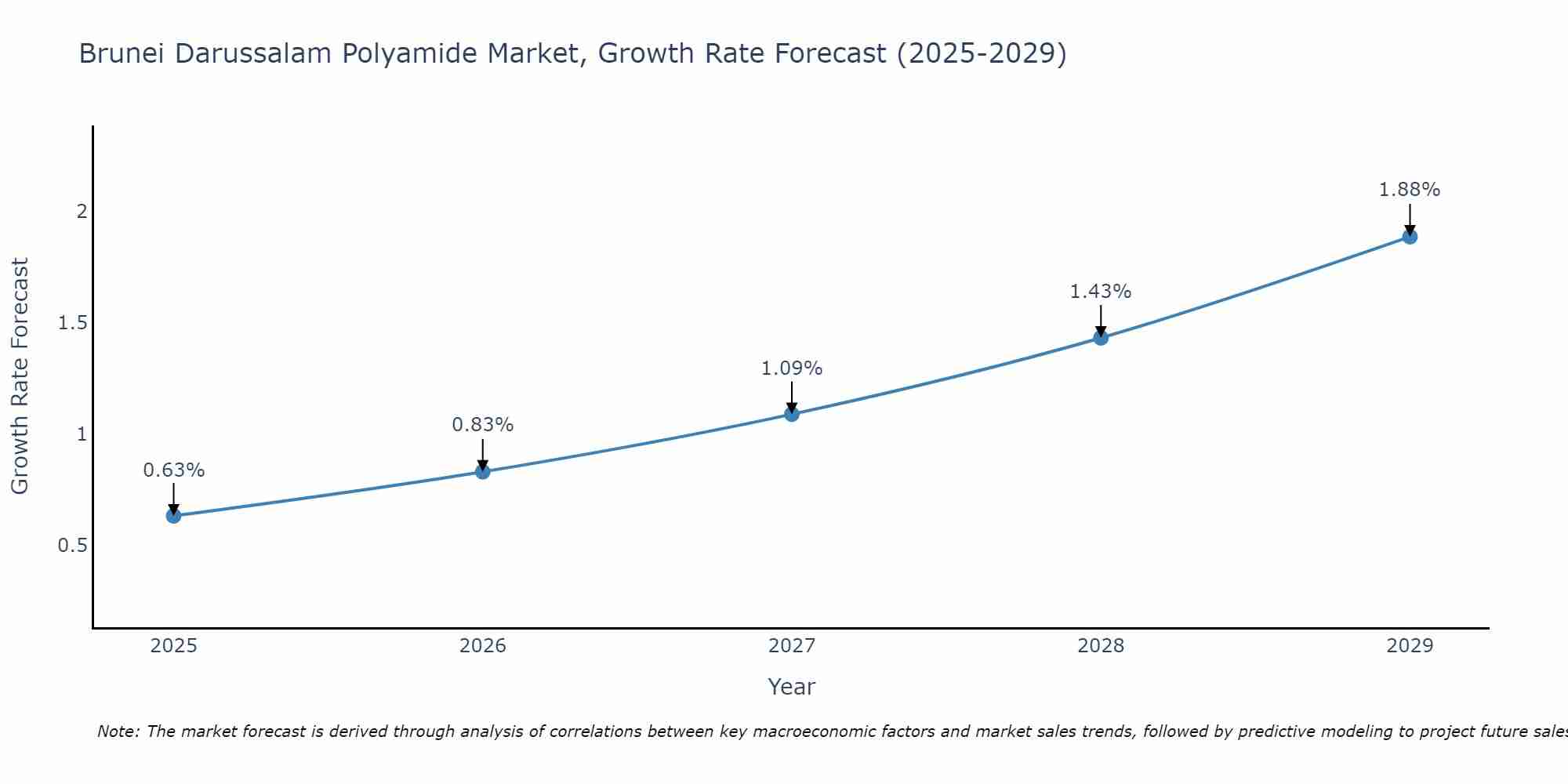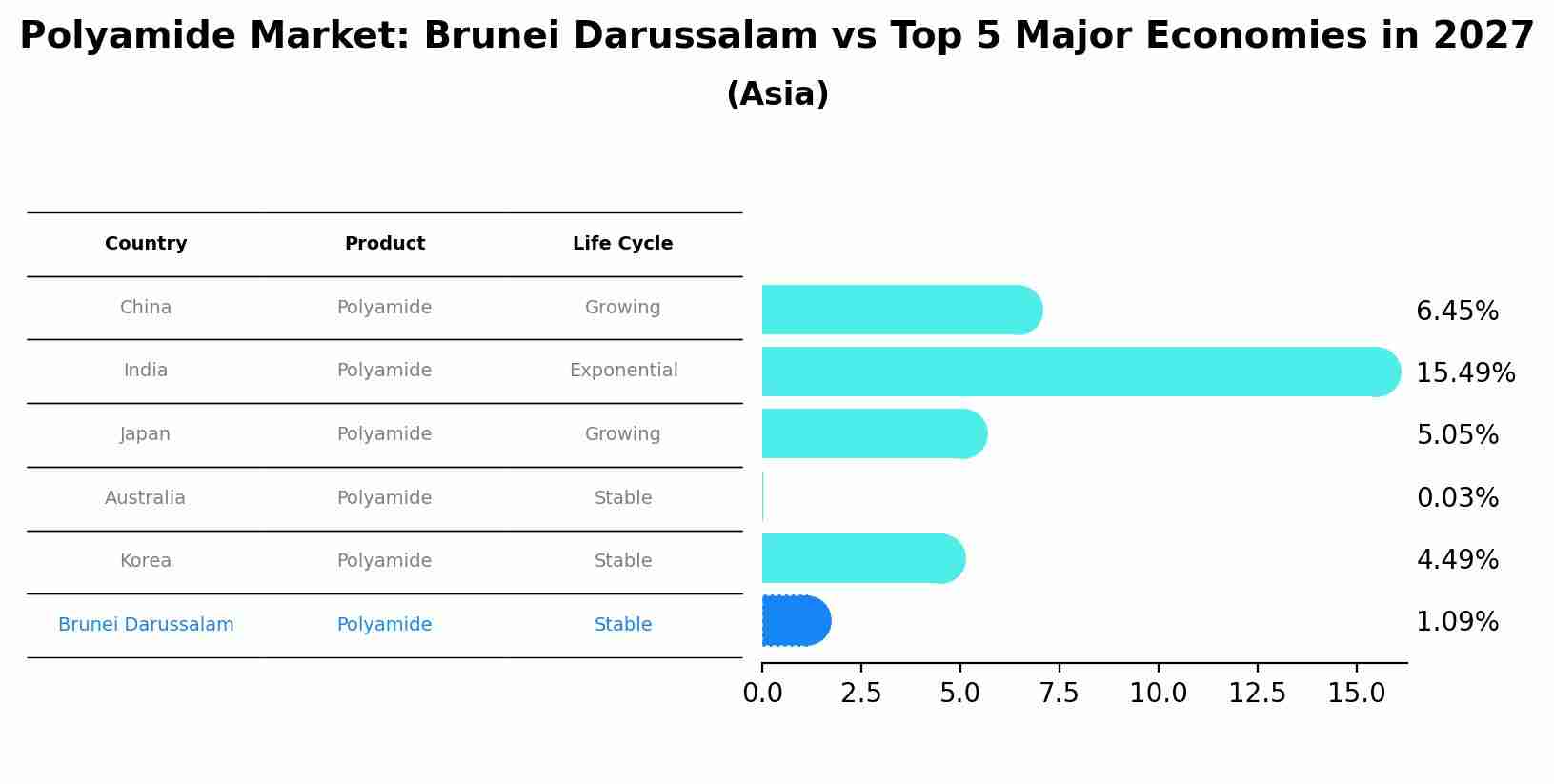Brunei Polyamide Market (2025-2031) | Companies, Revenue, Value, Share, Industry, Outlook, Trends, Growth, Size, Segmentation, Analysis & Forecast
| Product Code: ETC4665118 | Publication Date: Nov 2023 | Updated Date: Apr 2025 | Product Type: Market Research Report | |
| Publisher: 6Wresearch | Author: Shubham Deep | No. of Pages: 60 | No. of Figures: 30 | No. of Tables: 5 |
Brunei Darussalam Polyamide Market Size Growth Rate
The Brunei Darussalam Polyamide Market is poised for steady growth rate improvements from 2025 to 2029. From 0.63% in 2025, the growth rate steadily ascends to 1.88% in 2029.

Polyamide Market: Brunei Darussalam vs Top 5 Major Economies in 2027 (Asia)
The Polyamide market in Brunei Darussalam is projected to grow at a stable growth rate of 1.09% by 2027, within the Asia region led by China, along with other countries like India, Japan, Australia and South Korea, collectively shaping a dynamic and evolving market environment driven by innovation and increasing adoption of emerging technologies.

Brunei Polyamide Market Overview
Polyamide, or nylon, is used in textiles, automotive parts, and industrial applications. The Brunei market is influenced by demand for high-performance materials and the growth of manufacturing industries.
Drivers of the market
The polyamide market in Brunei benefits from the demand for this versatile polymer used in textiles, automotive parts, and industrial applications. Polyamides, including nylon, offer properties such as strength, durability, and resistance to abrasion. The growth of the textile and automotive industries and advancements in polyamide technology support market expansion.
Challenges of the market
The polyamide market in Brunei faces challenges related to raw material price fluctuations and competition from other polymers. Managing the cost of production and competing with alternative materials can impact market growth.
Government Policy of the market
Brunei`s regulations for the polyamide market focus on quality and safety. The government ensures that polyamide products meet specific criteria for performance and environmental impact. There is support for innovations in polyamide technology that improve the functionality and sustainability of polyamide materials.
Key Highlights of the Report:
- Brunei Polyamide Market Outlook
- Market Size of Brunei Polyamide Market, 2024
- Forecast of Brunei Polyamide Market, 2031
- Historical Data and Forecast of Brunei Polyamide Revenues & Volume for the Period 2021-2031
- Brunei Polyamide Market Trend Evolution
- Brunei Polyamide Market Drivers and Challenges
- Brunei Polyamide Price Trends
- Brunei Polyamide Porter`s Five Forces
- Brunei Polyamide Industry Life Cycle
- Historical Data and Forecast of Brunei Polyamide Market Revenues & Volume By Type for the Period 2021-2031
- Historical Data and Forecast of Brunei Polyamide Market Revenues & Volume By PA 6 for the Period 2021-2031
- Historical Data and Forecast of Brunei Polyamide Market Revenues & Volume By PA 66 for the Period 2021-2031
- Historical Data and Forecast of Brunei Polyamide Market Revenues & Volume By Bio-based & Specialty Polyamides for the Period 2021-2031
- Historical Data and Forecast of Brunei Polyamide Market Revenues & Volume By Application for the Period 2021-2031
- Historical Data and Forecast of Brunei Polyamide Market Revenues & Volume By Engineering Plastics for the Period 2021-2031
- Historical Data and Forecast of Brunei Polyamide Market Revenues & Volume By Fiber for the Period 2021-2031
- Brunei Polyamide Import Export Trade Statistics
- Market Opportunity Assessment By Type
- Market Opportunity Assessment By Application
- Brunei Polyamide Top Companies Market Share
- Brunei Polyamide Competitive Benchmarking By Technical and Operational Parameters
- Brunei Polyamide Company Profiles
- Brunei Polyamide Key Strategic Recommendations
Frequently Asked Questions About the Market Study (FAQs):
1 Executive Summary |
2 Introduction |
2.1 Key Highlights of the Report |
2.2 Report Description |
2.3 Market Scope & Segmentation |
2.4 Research Methodology |
2.5 Assumptions |
3 Brunei Polyamide Market Overview |
3.1 Brunei Country Macro Economic Indicators |
3.2 Brunei Polyamide Market Revenues & Volume, 2021 & 2031F |
3.3 Brunei Polyamide Market - Industry Life Cycle |
3.4 Brunei Polyamide Market - Porter's Five Forces |
3.5 Brunei Polyamide Market Revenues & Volume Share, By Type, 2021 & 2031F |
3.6 Brunei Polyamide Market Revenues & Volume Share, By Application, 2021 & 2031F |
4 Brunei Polyamide Market Dynamics |
4.1 Impact Analysis |
4.2 Market Drivers |
4.3 Market Restraints |
5 Brunei Polyamide Market Trends |
6 Brunei Polyamide Market Segmentations |
6.1 Brunei Polyamide Market, By Type |
6.1.1 Overview and Analysis |
6.1.2 Brunei Polyamide Market Revenues & Volume, By PA 6, 2021-2031F |
6.1.3 Brunei Polyamide Market Revenues & Volume, By PA 66, 2021-2031F |
6.1.4 Brunei Polyamide Market Revenues & Volume, By Bio-based & Specialty Polyamides, 2021-2031F |
6.2 Brunei Polyamide Market, By Application |
6.2.1 Overview and Analysis |
6.2.2 Brunei Polyamide Market Revenues & Volume, By Engineering Plastics, 2021-2031F |
6.2.3 Brunei Polyamide Market Revenues & Volume, By Fiber, 2021-2031F |
7 Brunei Polyamide Market Import-Export Trade Statistics |
7.1 Brunei Polyamide Market Export to Major Countries |
7.2 Brunei Polyamide Market Imports from Major Countries |
8 Brunei Polyamide Market Key Performance Indicators |
9 Brunei Polyamide Market - Opportunity Assessment |
9.1 Brunei Polyamide Market Opportunity Assessment, By Type, 2021 & 2031F |
9.2 Brunei Polyamide Market Opportunity Assessment, By Application, 2021 & 2031F |
10 Brunei Polyamide Market - Competitive Landscape |
10.1 Brunei Polyamide Market Revenue Share, By Companies, 2024 |
10.2 Brunei Polyamide Market Competitive Benchmarking, By Operating and Technical Parameters |
11 Company Profiles |
12 Recommendations | 13 Disclaimer |
- Single User License$ 1,995
- Department License$ 2,400
- Site License$ 3,120
- Global License$ 3,795
Search
Thought Leadership and Analyst Meet
Our Clients
Related Reports
- Canada Oil and Gas Market (2026-2032) | Share, Segmentation, Value, Industry, Trends, Forecast, Analysis, Size & Revenue, Growth, Competitive Landscape, Outlook, Companies
- Germany Breakfast Food Market (2026-2032) | Industry, Share, Growth, Size, Companies, Value, Analysis, Revenue, Trends, Forecast & Outlook
- Australia Briquette Market (2025-2031) | Growth, Size, Revenue, Forecast, Analysis, Trends, Value, Share, Industry & Companies
- Vietnam System Integrator Market (2025-2031) | Size, Companies, Analysis, Industry, Value, Forecast, Growth, Trends, Revenue & Share
- ASEAN and Thailand Brain Health Supplements Market (2025-2031) | Strategy, Consumer Insights, Analysis, Investment Trends, Opportunities, Growth, Size, Share, Industry, Revenue, Segments, Value, Segmentation, Supply, Forecast, Restraints, Outlook, Competition, Drivers, Trends, Demand, Pricing Analysis, Competitive, Strategic Insights, Companies, Challenges
- ASEAN Bearings Market (2025-2031) | Strategy, Consumer Insights, Analysis, Investment Trends, Opportunities, Growth, Size, Share, Industry, Revenue, Segments, Value, Segmentation, Supply, Forecast, Restraints, Outlook, Competition, Drivers, Trends, Demand, Pricing Analysis, Competitive, Strategic Insights, Companies, Challenges
- Europe Flooring Market (2025-2031) | Outlook, Share, Industry, Trends, Forecast, Companies, Revenue, Size, Analysis, Growth & Value
- Saudi Arabia Manlift Market (2025-2031) | Outlook, Size, Growth, Trends, Companies, Industry, Revenue, Value, Share, Forecast & Analysis
- Uganda Excavator, Crane, and Wheel Loaders Market (2025-2031) | Strategy, Consumer Insights, Analysis, Investment Trends, Opportunities, Growth, Size, Share, Industry, Revenue, Segments, Value, Segmentation, Supply, Forecast, Restraints, Outlook, Competition, Drivers, Trends, Demand, Pricing Analysis, Competitive, Strategic Insights, Companies, Challenges
- Rwanda Excavator, Crane, and Wheel Loaders Market (2025-2031) | Strategy, Consumer Insights, Analysis, Investment Trends, Opportunities, Growth, Size, Share, Industry, Revenue, Segments, Value, Segmentation, Supply, Forecast, Restraints, Outlook, Competition, Drivers, Trends, Demand, Pricing Analysis, Competitive, Strategic Insights, Companies, Challenges
Industry Events and Analyst Meet
Whitepaper
- Middle East & Africa Commercial Security Market Click here to view more.
- Middle East & Africa Fire Safety Systems & Equipment Market Click here to view more.
- GCC Drone Market Click here to view more.
- Middle East Lighting Fixture Market Click here to view more.
- GCC Physical & Perimeter Security Market Click here to view more.
6WResearch In News
- Doha a strategic location for EV manufacturing hub: IPA Qatar
- Demand for luxury TVs surging in the GCC, says Samsung
- Empowering Growth: The Thriving Journey of Bangladesh’s Cable Industry
- Demand for luxury TVs surging in the GCC, says Samsung
- Video call with a traditional healer? Once unthinkable, it’s now common in South Africa
- Intelligent Buildings To Smooth GCC’s Path To Net Zero


















